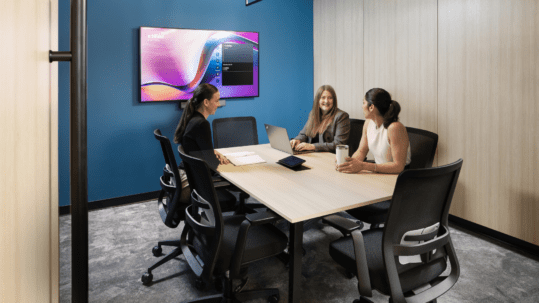When a workplace is designed with branded elements in mind, it can give the office a distinct identity, remind employees and clients why your organization exists, and encourage behaviours consistent with your company’s values and culture. Interior design is utilized by internationally recognized brands such as Dior, Apple, and Saint Laurent to curate a distinct feeling that can be associated with the company and to create spaces and designs that tell the company’s story. We spoke with our interior designer Camille Obianyor about her experience studying and working abroad, her experience with workplace branding and how her international perspective aids her current projects. Continue reading for more information on branded space design, environment styling, and European design.
Question 1: Tell us about your journey as an interior designer
I was born and raised in France and studied interior design in Paris. Throughout my bachelor’s degree, I was surrounded by classical architecture, constantly visiting museums and attending the latest design exhibitions by renowned designers. After graduating, I worked for Christian Dior Couture in the interior design department, where I learned more about commercial and retail design. While working at Dior, I got to work in the visual merchandising team, where I learned valuable lessons in visual communication, aesthetics, and brand identity. I solidified my passion for branding and curating a brand identity during this period. After working in France for several years, I wanted to see the world and increase my knowledge, so I relocated to Vancouver, Canada. When I first moved here, I worked in high-end residential design. I enjoyed the industry; however, I missed the branding aspect of commercial interior design.
Question 2: How do design and branding work together?
When it comes to high-end retail, design plays an integral role in branding and brand identification. When customers enter a showroom or head office, different visual elements combine to produce an essence specific to the company. Distinct colours, shapes, patterns, and textures can create a strong brand identity. When design goes beyond brand colours or a logo, it can convey particular emotions and feelings that can be seen and felt throughout a space. A solid visual identity through design allows people to walk into a room and recognize, understand, and distinguish a brand without the need for logos or products.
Question 3: How has your experience abroad helped you with your ability to help clients?
Studying and working abroad gave me knowledge of diverse ways of working. Working in France is quite different from working in Canada. My experience with varying workplace strategies can help clients find distinct ways to support their employee’s productivity, performance, and engagement. A diverse perspective on how people work allows me to be more flexible in my thinking. I have a wealth of design knowledge and awareness that extends beyond the borders of Canada; when designing a workplace, I can draw on the various inspirations I was exposed to abroad.
Question 4: What design elements or themes would you like to see more of in Canada?
I would love to see more daring colours, patterns, and textures incorporated into workplace design. European offices are more willing to be bolder, more interesting, or unusual in their design. In Vancouver, there is an appreciation for experimental designs, but there is a greater fondness for west coast style because it has its roots here. However, this should not prevent it from being influenced by other aspects, which can result in some funky hybrid designs, such as Japandi. Japandi is a style that combines Scandinavian and Japanese design elements. It would be exciting to see more refined European concepts incorporated into Canadian workplace design.
Question 5: Are there any recent design ideas you have seen and would like to include in a future project?
I have been recently reading a book called Joyful by Ingrid Fetell Lee. In this book, the author researches and gathers information about what makes people happier in life through design. She categorizes different areas that make people happy and then subcategorizes design elements that fall under every category. For example, there is energy affected by colour and light, and harmony is felt through repetition. Her perspective on how design can affect people’s happiness is a more holistic approach to design. Designers must consider how certain design choices affect wellness, team performance, and productivity. Of course, functionality is critical, but a genuinely thoughtful design goes beyond operability and considers how the workplace and its design can improve the lives of those who use it.
Question 6: What advice do you have for aspiring interior designers?
Surround yourself with things and people that inspire you. Inspiration can come from several sources. It is always wise to be around individuals who stimulate your creative energy.
At Aura, we are proud to have incredible designers from various backgrounds who bring unique perspectives and experiences to our team. We take pride in hiring people who think beyond functionality and go the extra mile to create experiential and engaging workplaces. If this sounds like you, check out our careers page to see our job vacancies.






